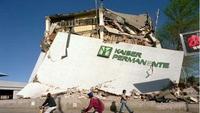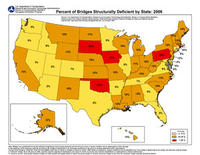-
Complicating the task of quantifying earthquake hazards in the Pacific Northwest
Nearly forgotten research from decades ago complicates the task of quantifying earthquake hazards in the Pacific Northwest, according to a new report from scientists at the U.S. Geological Survey, the University of Washington, and other universities. The report focuses on the Cascadia subduction zone — a giant active fault that slants eastward beneath the Pacific coast of southern British Columbia, Washington, Oregon, and northern California.
-
-
Research institutions must support strong, positive safety culture in chemical labs
Everyone involved in the academic chemical research enterprise — from researchers and principal investigators to university leadership — has an important role to play in establishing and promoting a strong, positive safety culture, says a new report from the National Research Council. This requires a constant commitment to safety organization-wide and emphasis on identifying and solving problems, rather than merely adhering to a set of rules and assigning blame when those rules are not followed.
-
-
Mapping Florida sinkholes
Sinkholes are common in Florida because of porous rock underground, such as limestone, which holds water. Over time, acid in the water dissolves the rock, creating a void. The Florida Geological Surveyand Florida Department of Emergency Managementare making progress on creating a statewide map showing where sinkholes are most likely to form. Florida received more than $1 million in federal funding last year to conduct a three-year study which would eventually help emergency planners predict where sinkholes are likely to develop, especially after large rainstorms.
-
-
Wastewater injection induces Oklahoma quakes: study
The dramatic increase in earthquakes in central Oklahoma since 2009 is likely attributable to subsurface wastewater injection at just a handful of disposal wells, finds a new study. The researchers say Oklahoma earthquakes constitute nearly half of all central and eastern U.S. seismicity from 2008 to 2013, many occurring in areas of high-rate water disposal.
-
-
L.A. to catalog buildings at risk of collapse during a major earthquake

After years of efforts to get officials to catalog buildings at risk of collapse during a major earthquake, Los Angeles City Council late last month instructed building officials to establish a database of such buildings. About 29,226 buildings built before 1978 are subject to survey, but city officials would use mapping programs to narrow down which structures need further field inspection. The city estimates roughly 5,800 buildings are at risk, and an additional 11,690 buildings will need inspection on site to determine whether they are soft-story buildings or not. Los Angeles has yet to decide what to do once it compiles the list, and whether to require retrofitting of vulnerable buildings, but seismic experts and policymakers insist that finding out which buildings are vulnerable is a necessary first step.
-
-
Real-time forecast of Hurricane Sandy accurately predicted storm’s track, intensity
A real-time hurricane analysis and prediction system that effectively incorporates airborne Doppler radar information may accurately track the path, intensity, and wind force in a hurricane. This system also can identify the sources of forecast uncertainty.
-
-
W.Va. spill leads lawmakers, industry to look at reforming toxic substances law
The government was slow to respond to the 9 January 2014 massive chemical spill in West Virginia because the law governing such response, the 1976 Toxic Substances Control Act (TSCA), limits regulatory agencies’ authority to investigate such spills.Under TSCA, the EPA must first prove that a chemical poses an unreasonable risk to health or the environment before it can require the needed testing that would show a potential risk. One observer called this a Catch-22, telling a congressional panel that “This is like requiring a doctor to prove that a patient has cancer before being able to order a biopsy.”
-
-
Improving common furniture fire test
In the United States, fires in which upholstered furniture is the first item ignited account for about 6,700 home fires annually and result in 480 civilian deaths, or almost 20 percent of home fire deaths between 2006 and 2010. A new study finds that the bench-scale test widely used to evaluate whether a burning cigarette will ignite upholstered furniture may underestimate the tendency of component materials to smolder when these materials are used in sofas and chairs supported by springs or cloth.
-
-
New L.A. fault map threatens Hollywood development projects
The state of California recently released new geological maps which reveal the presence of an active earthquake fault along the path of major developments in Hollywood. The maps established a zone of 500 feet on both sides of the fault, and state law will require new developments within the zone to conduct underground seismic testing to determine whether the fault runs beneath planned development sites. Building on top of faults is prohibited. Three prominent Hollywood developments — the Millennium Hollywood skyscraper project, the Blvd6200 development, and an apartment project on Yucca Street — are within the 500-foot fault zone.
-
-
Surviving a nuclear explosion in your city

During the cold war, scientists modeled every imaginable consequence of a nuclear explosion. Michael Dillon, a Lawrence Livermore Lab mathematician, found a gap in the sheltering strategies for people far enough from ground zero to survive the initial blast but close enough to face deadly radioactive fallout. Dillon’s model’s addresses the most vulnerable people, those who found shelter from the blast in lightweight buildings, or buildings lacking a basement (these buildings are more easily penetrated by deadly radioactive dust). His recommendations: if adequate shelter is fifteen minutes away, people should remain in their initial, poor-quality shelter no longer than thirty minutes after detonation. If the better shelter is only five minutes away, however, individuals should move there immediately, leaving the closer but unsafe buildings altogether.
-
-
Canadian city developed mathematical formula to evaluate risk
The City of Hamilton, Ontario has ranked Terrorism fourth on its list of top ten emergency risks, below Hazardous Materials and Explosions, Energy Supply Emergencies, and Epidemics/Pandemics.The city’s ranking of top 10 emergencies for which it plans is not a mere judgment call: The city’s emergency management office uses a mathematical equation to rate the risks to the city and its population.
-
-
Thousands of U.S. bridges in “fracture critical” condition

There are currently 66,749 structurally deficient bridges and 84,748 functionally obsolete bridges in the United States – about a quarter of the nation’s 607,000 bridges. With declining federal funds for bridge repair, the burden of maintenance has shifted to states, which spent $28.5 billion last year on bridge work – up from $12.3 billion in 1998.
-
-
DHS chemical plant security program hobbled by problems, poor oversight
A DHS program responsible for the security of chemical facilities, such as the West Fertilizer Company plant in Texas, has been ineffective owing to a number of issues, leading federal investigators to wonder “whether it can achieve its mission, given the challenges the program continues to face.”
-
-
Finding the right balance for natural hazard mitigation
Uncertainty issues are paramount in the assessment of risks posed by natural hazards and in developing strategies to alleviate their consequences.Researchers describe a model that estimates the balance between costs and benefits of mitigation — efforts to reduce losses by taking action now to reduce consequences later — following natural disasters, as well as rebuilding defenses in their aftermath.
-
-
Enhancing Army capabilities as new threats emerge
Some twenty-eight nations have some type of weapons of mass destruction capability, with some of them having nuclear weapons or nuclear-weapons capability. The nuclear materials in many of these countries are kept in hundreds of sites without global safeguards in place for securing them. A senior American military official described these loose nukes as the “single biggest existential threat to Western survival.” Yet, in a recent exercise, the U.S. response time for deploying 90,000 troops to a crisis area – an area which included loose nukes, other WMDs, or both — took fifty-five days. U.S. military leaders say this is just not good enough.
-
More headlines
The long view
Risk Assessment with Machine Learning
Researchers utilize geological survey data and machine learning algorithms for accurately predicting liquefaction risk in earthquake-prone areas.
